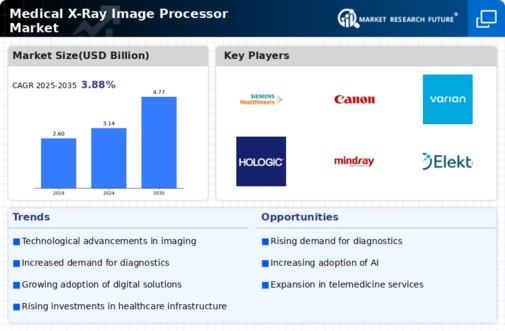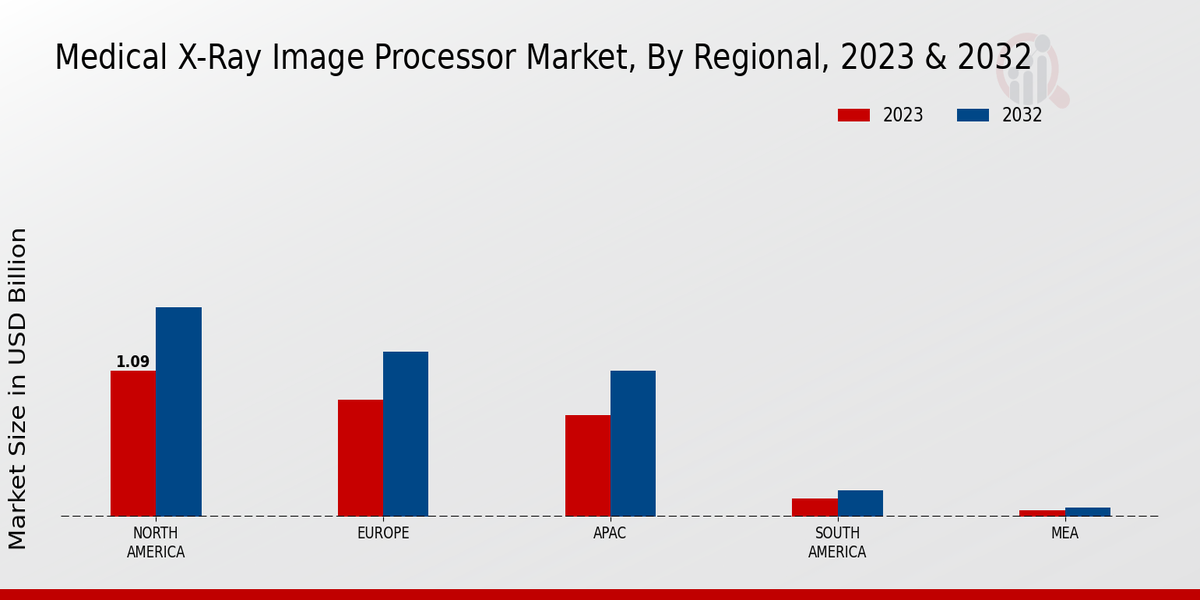Technological Advancements
The Global Medical X-Ray Image Processor Market Industry is experiencing rapid technological advancements, which enhance the quality and efficiency of imaging processes. Innovations such as digital radiography and advanced image processing algorithms are becoming increasingly prevalent. These technologies not only improve diagnostic accuracy but also streamline workflows in healthcare facilities. For instance, the integration of artificial intelligence in image processing is expected to reduce the time required for image analysis, thereby increasing throughput. As a result, the market is projected to grow from 3.14 USD Billion in 2024 to 4.77 USD Billion by 2035, reflecting a growing demand for sophisticated imaging solutions.
Market Trends and Projections
Increased Healthcare Expenditure
The Global Medical X-Ray Image Processor Market Industry is positively influenced by rising healthcare expenditure across various regions. Governments and private entities are allocating more resources to enhance healthcare infrastructure, which includes upgrading imaging facilities. For example, countries are investing in modernizing hospitals and clinics with state-of-the-art imaging equipment to improve diagnostic capabilities. This trend is expected to drive the market's growth, as increased funding allows for the acquisition of advanced x-ray image processors. As healthcare spending continues to rise, the industry is likely to see sustained demand for innovative imaging solutions that meet the evolving needs of healthcare providers.
Regulatory Support and Standards
The Global Medical X-Ray Image Processor Market Industry benefits from robust regulatory support and established standards that ensure the safety and efficacy of imaging technologies. Regulatory bodies, such as the Food and Drug Administration, are actively involved in the approval and monitoring of medical imaging devices. This regulatory framework not only fosters innovation but also instills confidence among healthcare providers and patients. As regulations evolve to accommodate new technologies, the market is likely to expand, with manufacturers investing in compliance and quality assurance. This supportive environment is essential for sustaining growth in the industry, particularly as new imaging modalities emerge.
Rising Demand for Diagnostic Imaging
The Global Medical X-Ray Image Processor Market Industry is witnessing a surge in demand for diagnostic imaging services. This trend is driven by an increasing prevalence of chronic diseases and a growing aging population that requires regular medical evaluations. The World Health Organization indicates that the demand for imaging services is likely to rise as healthcare providers seek to improve patient outcomes through early diagnosis. Consequently, this heightened demand is projected to contribute to a compound annual growth rate of 3.87% from 2025 to 2035. This growth underscores the necessity for advanced x-ray processing technologies that can handle increased imaging volumes effectively.
Growing Awareness of Preventive Healthcare
The Global Medical X-Ray Image Processor Market Industry is experiencing growth due to an increasing awareness of preventive healthcare among the population. As individuals become more informed about the benefits of early detection and regular health screenings, the demand for diagnostic imaging services is likely to rise. This shift in consumer behavior encourages healthcare providers to invest in advanced x-ray image processing technologies that facilitate timely and accurate diagnoses. The emphasis on preventive care is expected to contribute to the market's expansion, as more patients seek imaging services to monitor their health proactively.























